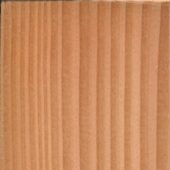Douglas fir (Pseudotsuga menziesii)
The Douglas Fir (Pseudotsuga menziesii) is a pine/softwood from the Conifer family (Pinaceae). Douglas firs are often wrongly referred to as Douglas spruce or Douglas pine.
Natural range
Originally, the Douglas fir was only native to the west coast of North America, from British Columbia to Mexico, mainly in Oregon (“Oregon pine”), but has now been introduced in many different countries of the world. In central Europe, they are planted in great abundance in forestry areas, but also in parks and garden. It has meanwhile become very widespread through natural rejuvenation.
Description of the wood
The three to six millimetres of sapwood is white to cream-coloured and is easily distinguished from the yellowish-brown to reddish-brown heartwood, which also darkens considerably after cutting. Its basic density is 0.64 g/cm³ on average. It is stronger than pine, though the timber from the European strains is not as hard as that of its North American cousins.
Workability
Douglas fir can be worked easily with all manual and mechanical tools, though its high resin content can pose problems as it sticks to the blades. For nails or screws, holes should really be drilled in the timber beforehand, as it tends to crack easily.
Durability
While the heartwood of the Douglas fir in its natural North American habitat is classified as moderately durable (durability class 3), the heartwood of the European Douglas fir is only slightly or non-durable in resisting infestation by wood-destroying fungi (durability class 3 – 4, acc. to DIN EN 350-2) and is vulnerable to insect attack. The sapwood is non-durable (durability class 5).
Treatability
The heartwood is practically untreatable (treatability class 4, acc. to DIN EN 350-2). Douglas fir sapwood is moderately resistant to resistant (treatability class 2 to 3), similar to pine or spruce. With the appropriate process parameters, Douglas fir can be well protected by vacuum pressure treatment.
Applications
Douglas fir wood is very versatile in its applications. It can be used outside as a constructional timber (chemically treated) for moderate duty exposure in earthworks and water engineering, for ships’ masts, driven piles and sleepers. Other special external applications include bridges, timber frameworks and noise barriers. In house building, Douglas fir is used for roof, wall and ceiling structures, for framework constructions, roof eaves, balconies, doors and gates, windows and facade elements. Its expressive grain structure makes it very popular for veneers in furniture making or for use in parquet, furniture and panelling.
